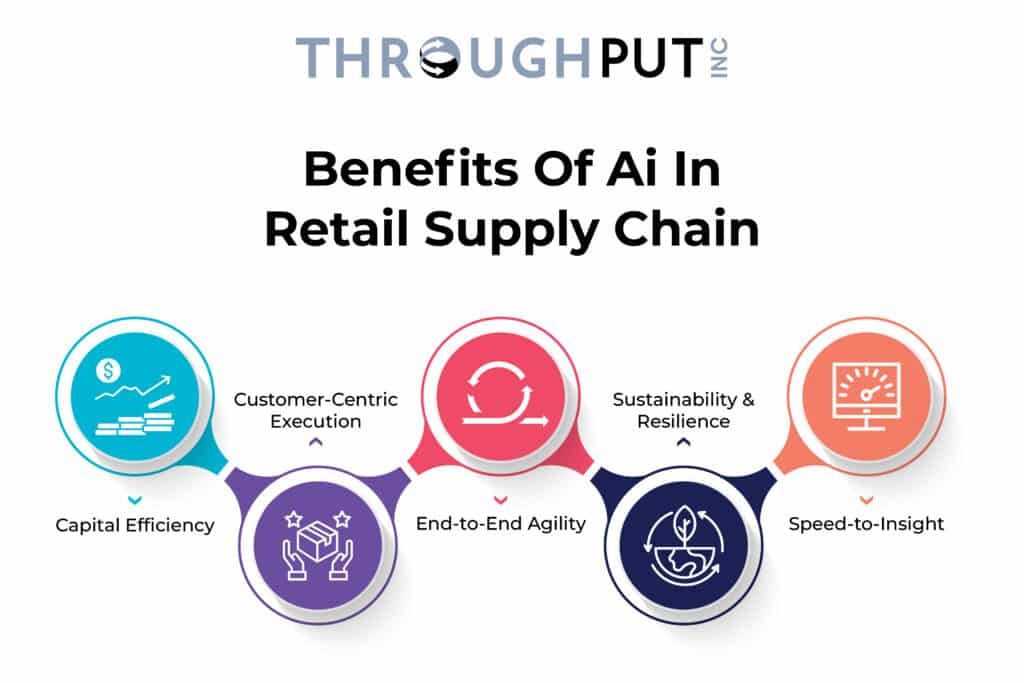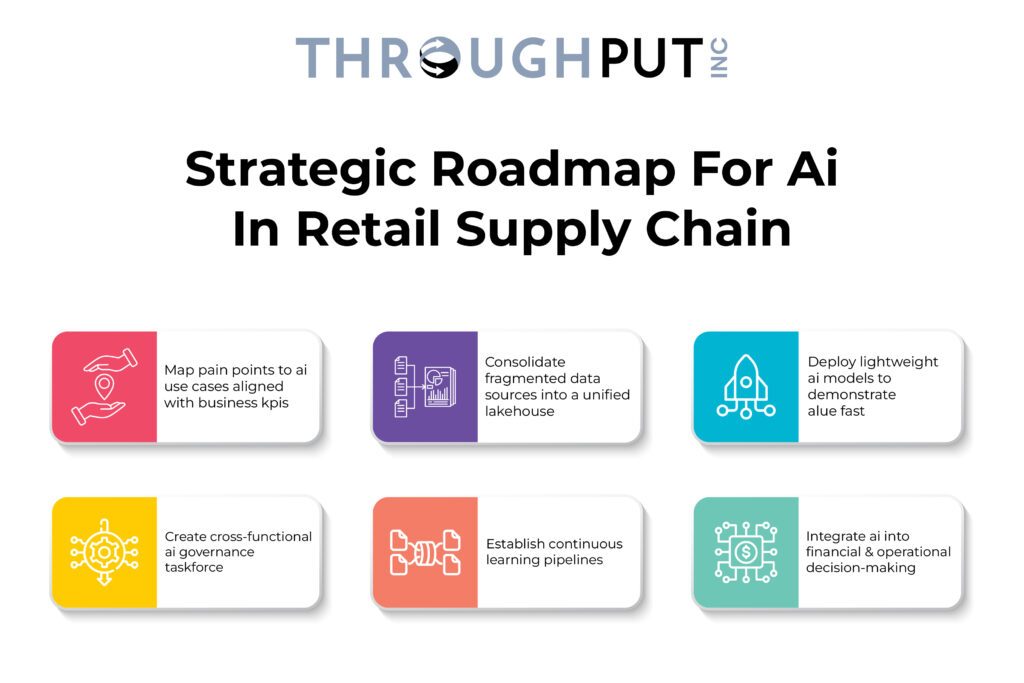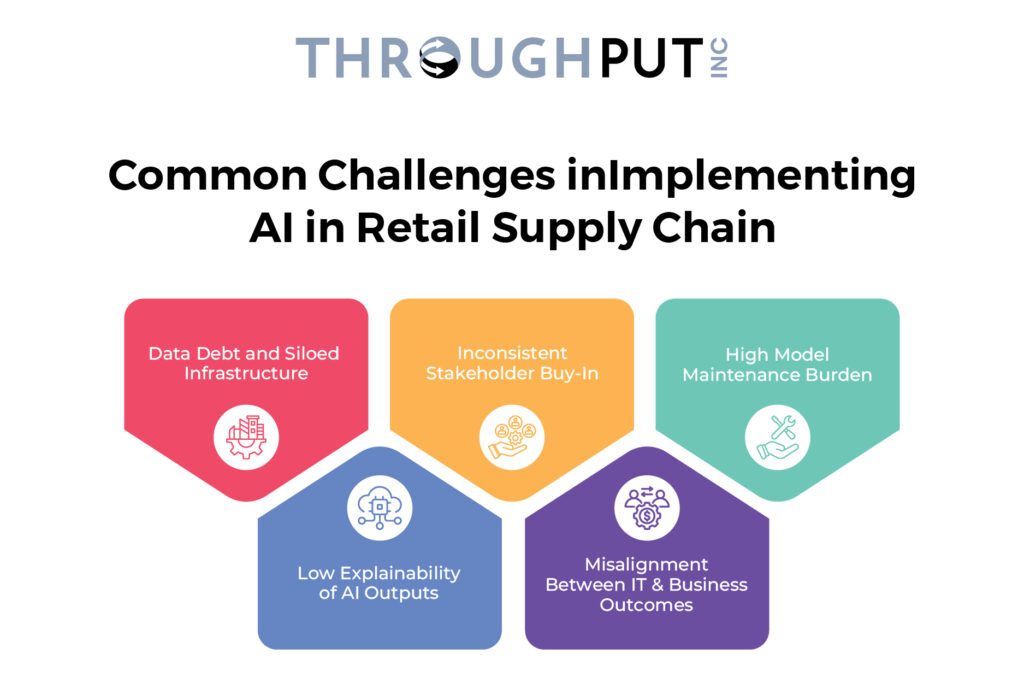In the age of relentless disruption, razor-thin margins, and digitally empowered customers, the retail industry must rapidly evolve to stay relevant. AI in retail supply chain is no longer an innovation to observe—it’s a strategic imperative to adopt. Artificial Intelligence empowers retailers to pivot from reactive to predictive, manual to autonomous, fragmented to connected. By infusing intelligence into every supply chain touchpoint—from sourcing to shelf—AI is driving operational excellence, customer satisfaction, and exponential growth.
AI in Retail Supply Chain – A Comprehensive Overview
- What is AI in Retail Supply Chain?
- The Strategic Shift: How AI is Reshaping Retail Supply Chain
- High-Impact Use Cases of AI in Retail Supply Chain
- Core Benefits of AI in Retail Supply Chain
- Where AI Delivers Strategic Value in Retail Supply Chain
- Enterprise AI Adoption: Strategic Roadmap for AI in Retail Supply Chain
- Generative AI in Retail Supply Chain: The Next Frontier
- Best Practices for AI Execution in Retail Supply Chain
- Common Challenges in Implementing AI in Retail Supply Chain
- Why ThroughPut.AI is a Game-Changer for AI in Retail Supply Chain
What is AI in Retail Supply Chain?
AI in retail supply chain refers to the deployment of intelligent algorithms—including machine learning, predictive analytics, computer vision, and generative AI—to digitize, optimize, and accelerate retail business operations. Within supply chains, AI acts as the control tower—intercepting real-time data, predicting outcomes, and prescribing optimal actions.
The Strategic Shift: How AI is Reshaping Retail Supply Chain
Modern retail is characterized by hyper-personalization, dynamic fulfillment, and real-time adaptability. AI in retail supply chain is fueling this shift through:
Hyper-Personalized Customer Journeys: AI captures behavioral signals and translates them into tailored offers, personalized recommendations, and dynamic pricing strategies.
Cognitive Inventory Planning: AI continuously aligns procurement strategies with shifts in customer demand, promotional calendars, and macroeconomic conditions.
Autonomous Supply Chain Execution: AI systems self-correct logistics bottlenecks and automatically adjust workflows to maintain performance SLAs.
AI-Driven Category Management: Advanced analytics identify optimal product mix and placement, boosting category performance and revenue per square foot.

High-Impact Use Cases of AI in Retail Supply Chain
| Strategic Area | AI-Driven Use Case | Business Outcome |
| Demand Forecasting | Multi-variable AI models to predict SKU-level demand | 30–40% improvement in forecast accuracy |
| Inventory Planning | Predictive analytics for JIT replenishment | 25% reduction in excess stock, 15% increase in turnover |
| Fulfillment & Logistics | Route optimization, dynamic ETAs, auto-replenishment | 20–30% improvement in OTD (on-time delivery) |
| Merchandising | AI for real-time pricing and promotion optimization | 10–15% increase in margin capture |
| Store Ops | AI-optimized planograms, footfall prediction | Higher customer satisfaction, better shelf availability |
| Returns Management | Automated disposition and reverse logistics routing | 20% reduction in processing time, 10% in return costs |
Core Benefits of AI in Retail Supply Chain
- Speed-to-Insight: Real-time predictive intelligence across all nodes, enabling faster, data-backed decision-making.
- Capital Efficiency: Minimized inventory holding costs through just-in-time restocking and accurate demand matching.
- Customer-Centric Execution: Improved fill rates and on-shelf availability keep customers loyal and conversion rates high.
- End-to-End Agility: From seasonal peaks to supplier delays, AI in retail supply chain ensures rapid re-optimization across the value chain.
- Sustainability & Resilience: Efficient resource use reduces environmental impact while preparing for unexpected disruptions.

Where AI Delivers Strategic Value in Retail Supply Chain?
- Real-Time Demand Sensing at SKU + Store Level: Captures granular demand patterns to enable localized inventory decisions.
- Automated Multi-Echelon Replenishment: Coordinates inventory across warehouses, DCs, and stores to reduce waste.
- Smart In-Transit Inventory Redistribution: Redirects shipments mid-route based on updated demand forecasts.
- Cross-Channel Fulfillment Optimization (BOPIS, Dropship, Store-to-Door): Ensures fastest, most cost-effective fulfillment route.
- AI-Powered Supplier Performance Management: Evaluates supplier reliability and risk in real time, ensuring continuity.
- Markdown Optimization & Season-End Planning: Uses historical data and pricing elasticity to optimize clearance strategies.
Enterprise AI Adoption: Strategic Roadmap for AI in Retail Supply Chain
- Map Pain Points to AI Use Cases Aligned with Business KPIs: Identify supply chain inefficiencies and match them to proven AI in retail supply chain applications.
- Consolidate Fragmented Data Sources into a Unified Lakehouse: Centralize data across systems for comprehensive visibility.
- Deploy Lightweight AI Models to Demonstrate Value Fast: Start small with quick-win use cases to build organizational trust.
- Create Cross-Functional AI Governance Taskforce: Align IT, operations, finance, and business to manage deployment and performance.
- Establish Continuous Learning Pipelines: Enable models to evolve with market signals, demand shifts, and supply dynamics.
- Integrate AI into Financial and Operational Decision-Making: Embed insights into dashboards, workflows, and planning cycles.

Generative AI in Retail Supply Chain: The Next Frontier
Generative AI is not just about chatbots—it’s revolutionizing AI in retail supply chain by:
- Auto-generation of Optimal Demand Plans: Trained on millions of SKUs, generative AI crafts actionable, adaptive demand scenarios.
- Scenario Planning and Shock Simulations: Simulate macroeconomic shifts, weather events, or geopolitical risks in minutes.
- AI-Generated PO Schedules and Dynamic Sourcing Strategies: Enable procurement teams to execute faster and smarter.
- Narrative BI: AI-Generated Reports for Executive Insights: Convert raw data into contextual summaries for CXOs and board meetings.

Best Practices for AI Execution in Retail Supply Chain
- Adopt a Value-First, Not Tech-First Mindset: Start with measurable business goals, not experimental pilots.
- Design AI Models for Explainability and Trust: Ensure all stakeholders can interpret AI logic and output.
- Standardize Metrics Across Teams: Align KPIs so that supply chain, finance, and sales speak a common language.
- Align AI KPIs with Revenue, Working Capital & Customer Metrics: Track business impact from day one.
- Invest in Change Management and Reskilling: Upskill your workforce to extract full value from AI in retail supply chain tools.
Common Challenges in Implementing AI in Retail Supply Chain
- Data Debt and Siloed Infrastructure: Legacy systems often inhibit data fluidity and quality.
- Inconsistent Stakeholder Buy-In: Success depends on organization-wide alignment and participation.
- High Model Maintenance Burden: AI models must continuously evolve to remain effective.
- Low Explainability of AI Outputs: Black-box outputs hinder decision-maker trust.
- Misalignment Between IT & Business Outcomes: AI must serve both technical scalability and commercial value1.

Why ThroughPut.AI is a Game-Changer for AI in Retail Supply Chain?
ThroughPut.AI stands out as a transformative force in the world of AI in retail supply chain, delivering targeted, data-driven solutions that address the most pressing challenges facing modern retailers. Here’s how ThroughPut.AI is redefining supply chain excellence:
- Real-Time, SKU-Level Demand Sensing and Predictive Accuracy
ThroughPut.AI leverages advanced AI algorithms to provide sub-day visibility into demand fluctuations at the SKU and store level. This enables retailers to anticipate shifts in consumer behavior, respond faster to market changes, and maintain optimal inventory levels—reducing excess stock and preventing costly stockouts.
- Automated Inventory Balancing Across Locations
The platform dynamically optimizes inventory across warehouses, distribution centers, and stores. By continuously analyzing real-time data, ThroughPut.AI ensures products are available where and when they are needed most, improving in-stock rates and customer satisfaction while minimizing carrying costs
- Financially-Aware Supply Chain Decisions
ThroughPut.AI uniquely ties supply chain actions directly to profitability. Its AI-driven recommendations are designed to maximize margins and align with business KPIs, ensuring that every decision—from replenishment to markdowns—supports both operational efficiency and financial goals
- Seamless Integration with Existing Systems
Retailers can deploy ThroughPut.AI without the need for disruptive “rip-and-replace” projects. The platform integrates smoothly with existing technology stacks, allowing businesses to unlock AI-powered benefits quickly and with minimal risk
- Rapid, Measurable ROI
Retailers using ThroughPut.AI have reported remarkable results, including:
- 40% reduction in excess inventory
- 35% increase in in-stock availability
- 3x faster response to demand shifts
- 5–8% improvement in bottom-line margins within just 90 days
- Designed for Modern Retail Complexity
ThroughPut.AI is built to handle the challenges of today’s multi-channel, high-velocity retail environments. Its platform supports everything from demand forecasting and automated replenishment to logistics optimization and supplier performance management, all powered by next-generation AI capabilities
- No-Risk, High-Impact Deployment
With quick implementation and proven outcomes, ThroughPut.AI enables retailers to future-proof their supply chains, drive sustainable growth, and consistently exceed customer expectations—without overhauling their existing infrastructure
ThroughPut.AI is not just another supply chain tool—it’s a strategic partner for retailers seeking to unlock the full potential of AI in retail supply chain planning. With ThroughPut.AI, you gain the intelligence, speed, and flexibility needed to deliver superior customer experiences, maximize profitability, and future-proof your retail operations.
Advanced FAQs: AI in Retail Supply Chain
Q1. What KPIs should we measure when deploying AI in retail supply chains?
A: Forecast Accuracy, Inventory Turns, On-Shelf Availability, Fill Rate, Demand-Sensing Latency, and OTD (on-time delivery).
Q2. How does AI help unify digital and physical supply chains?
A: By providing real-time inventory visibility and AI-powered orchestration across stores, warehouses, and fulfillment centers.
Q3. What differentiates a high-performing AI retail platform?
A: Speed to deployment, explainability, industry context, and ability to scale across use cases without needing data scientists.
Q4. Can generative AI create supply chain plans?
A: Yes. Generative AI can auto-generate demand plans, simulate stress scenarios, and write exec-level summaries in real time.
Q5. What’s the fastest path to AI ROI in retail?
A: Start with demand sensing + inventory optimization. They deliver quick cost savings and immediate revenue protection.
Final Thoughts
AI in retail supply chain is not just changing how retail supply chains operate—it’s redefining what’s possible. The leaders of tomorrow are already scaling AI today. Retailers that adopt advanced AI-driven approaches are future-proofing their operations, unlocking new profit pools, and building resilient, agile, and customer-centric ecosystems.
With ThroughPut.AI, you don’t just digitize your supply chain—you make it intelligent, adaptive, and financially optimized.


